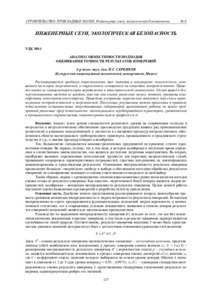Please use this identifier to cite or link to this item:
https://elib.psu.by/handle/123456789/13971Full metadata record
| DC Field | Value | Language |
|---|---|---|
| dc.contributor.author | Серенков, П. С. | - |
| dc.date.accessioned | 2015-10-02T12:19:16Z | - |
| dc.date.available | 2015-10-02T12:19:16Z | - |
| dc.date.issued | 2015 | - |
| dc.identifier.citation | Вестник Полоцкого государственного университета. Серия F, Строительство. Прикладные науки. - 2015. - № 8. - С.127-131. | ru_RU |
| dc.identifier.issn | 2070-1683 | - |
| dc.identifier.uri | https://elib.psu.by/handle/123456789/13971 | - |
| dc.description | The Analysis of the Compatibility of Approaches to Estimation of Measurement Results. P. Serenkovdr. Sci. Sciences, Associate Professor (Belarusian National Technical University, Minsk) | ru_RU |
| dc.description.abstract | Рассматривается проблема совместимости двух подходов в метрологии: классического, основанного на теории погрешностей, и современного, основанного на концепции неопределенности. Приведен анализ их соответствия теории вероятности и математической статистики. Сделан вывод о бес перспективности сведения их воедино, так как они имеют различную логику, понятия, принципы классификации источников изменчивости. Приведены алгоритмы корректного взаимного пересчета характеристик неопределенностей и погрешностей. Полученные результаты можно применять в практике деятельности испытательных аккредитованных лабораторий, выполняющих работы по заказу предприятий различных сфер деятельности: магистрального трубопроводного транспорта, гражданского и промышленного строительства, машиностроительного профиля и т.д.= The problem of compatibility of the two approaches in metrology: classic, based on the errors theory, and modern, based on the uncertainty concept, is investigated. The analysis of their compliance with the probability theory and mathematical statistics is presented. The conclusion about the futility of their consolidation, as they have a different logic, concepts, principles, classification of sources of variability, is justified. Algorithms correct mutual conversion characteristics of uncertainties and errors are offered. The given results can be applied in work practice of test accredited laboratories which fulfill contracts with many companies of different industrial areas: main pipeline transport, civil and industrial building, machine-building sphere etc. | ru_RU |
| dc.language.iso | ru | ru_RU |
| dc.publisher | Полоцкий государственный университет | ru_RU |
| dc.relation.ispartof | Веснік Полацкага дзяржаўнага ўніверсітэта. Серыя F, Будаўніцтва. Прыкладныя навукі | be_BE |
| dc.relation.ispartof | Herald of Polotsk State University. Series F, Civil engineering. Applied sciences | en_EN |
| dc.relation.ispartof | Вестник Полоцкого государственного университета. Серия F. Строительство. Прикладные науки | ru_RU |
| dc.relation.ispartofseries | Серия F. Строительство. Прикладные науки;2015. - № 8 | - |
| dc.rights | open access | ru_RU |
| dc.subject | Государственный рубрикатор НТИ - ВИНИТИ::МЕЖОТРАСЛЕВЫЕ ПРОБЛЕМЫ::Метрология | ru_RU |
| dc.subject | Метрологическое обеспечение | ru_RU |
| dc.subject | аккредитованные лаборатории | ru_RU |
| dc.subject | процедуры метрологического обеспечения | ru_RU |
| dc.subject | результаты измерения | ru_RU |
| dc.subject | методы оценки точности измерений | ru_RU |
| dc.title | Анализ совместимости подходов оценивания точности результатов измерений | ru_RU |
| dc.type | Article | ru_RU |
| dc.identifier.udc | 389.1 | - |
| Appears in Collections: | 2015, № 8 | |
Files in This Item:
| File | Description | Size | Format | |
|---|---|---|---|---|
| 127-131.pdf | 172.93 kB | Adobe PDF |  View/Open |
Items in DSpace are protected by copyright, with all rights reserved, unless otherwise indicated.